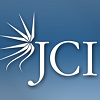Smooth-muscle BMAL1 participates in blood pressure circadian rhythm regulation
Zhongwen Xie, etc
JCI,
2015
As the central pacemaker, the suprachiasmatic nucleus (SCN) has long been considered the primary regulator of blood pressure circadian rhythm; however, this dogma has been challenged by the discovery that each of the clock genes present in the SCN is also expressed and functions in peripheral tissues. The involvement and contribution of these peripheral clock genes in the circadian rhythm of blood pressure remains uncertain. Here, we demonstrate that selective deletion of the circadian clock transcriptional activator aryl hydrocarbon receptor nuclear translocator–like (Bmal1) from smooth muscle, but not from cardiomyocytes, compromised blood pressure circadian rhythm and decreased blood pressure without affecting SCN-controlled locomotor activity in murine models. In mesenteric arteries, BMAL1 bound to the promoter of and activated the transcription of Rho-kinase 2 (Rock2), and Bmal1 deletion abolished the time-of-day variations in response to agonist-induced vasoconstriction, myosin phosphorylation, and ROCK2 activation. Together, these data indicate that peripheral inputs contribute to the daily control of vasoconstriction and blood pressure and suggest that clock gene expression outside of the SCN should be further evaluated to elucidate pathogenic mechanisms of diseases involving blood pressure circadian rhythm disruption.
Vector Biolabs
293 Great Valley Parkway
Malvern, PA 19355
Email: info@vectorbiolabs.com
Phone: +1 484-325-5100
Toll-free (US Only): 877-BIO-LABS
Fax: +1 215-525-1112
Privacy Policy

